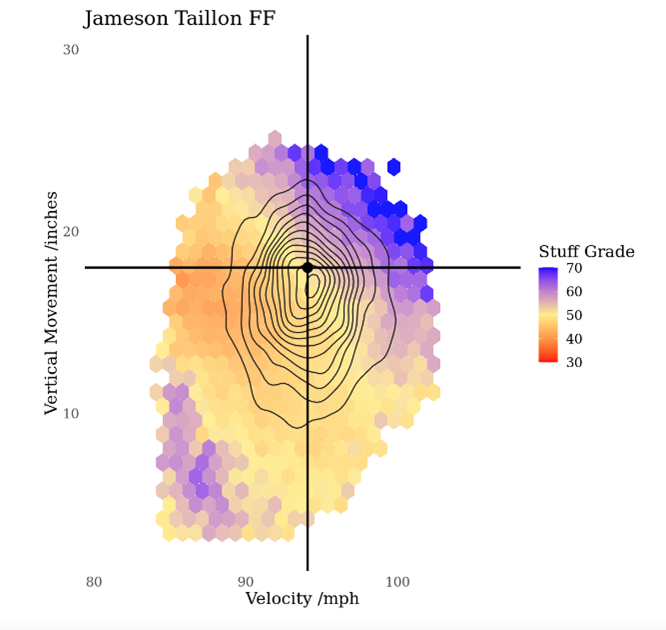
Over the last decade, many new pitching stats have been created, including FIP, SIERA, CSW%, and xFIP, all with the single purpose of getting a better understanding of a pitcher’s ability beyond the ERA. Recently, a new pitching stat was created by Eno Sarris which he calls Stuff+.
What is it? and how can it be helpful?
This metric takes the physical components of each pitch and gives it a grade on a scale of 100 in order to evaluate how effective the pitch is compared to others. On this scale, a pitch with a Stuff+ grade of 100 would be average, any number above 100 would be above average, and any number below 100 would be below average.
Soon after, another model was created by data scientist Cameron Grove, who now works for the Cleveland Guardian’s R&D staff. While these models are very similar, the main difference is that Grove’s Stuff+ model is scaled on a 20-80 scouting scale, where 50 is average and every 10 points is 1 standard deviation (SD) away from the mean (ex: a score of 60 would be 1 SD above average and a score of 40 would be 1 SD below average).
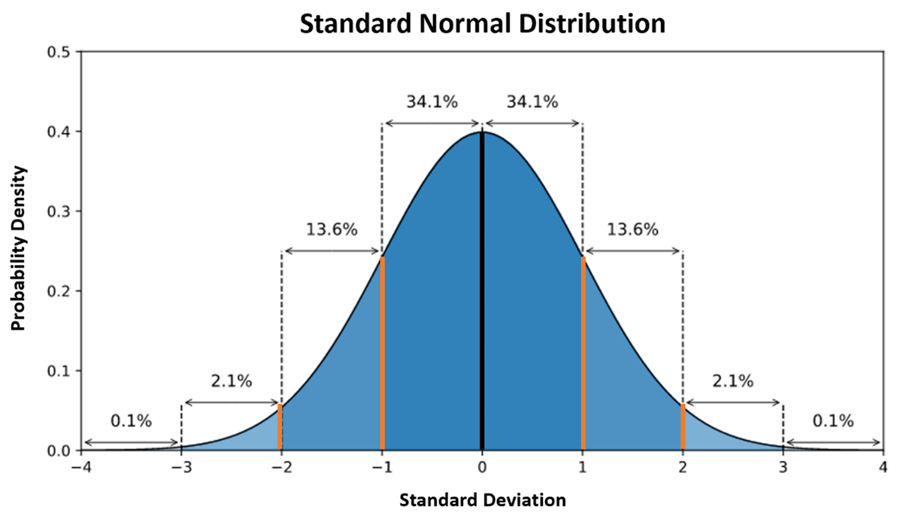
What is Considered in the Stuff+ Statistic?
Stuff+ uses the movement profile of each pitch to try and estimate how deceptive or “nasty” a pitch is. For fastballs, Stuff+ considers the following attributes:
-
- Velocity
- Vertical Break
- Horizontal Break
- Spin
- Horizontal Release Point
- Vertical Release Point
- Extension
For Breaking Balls / Off-speed Pitches, it also considers:
-
- Velo Difference from Fastball
- Vertical Break Difference from Fastball
- Horizontal Break Difference From Fastball
Stuff+ then applies different weights to these attributes (based on pitch type) to evaluate how effective this pitch moves. Here’s an example of how a breaking ball is weighted in Eno Sarris’s model:
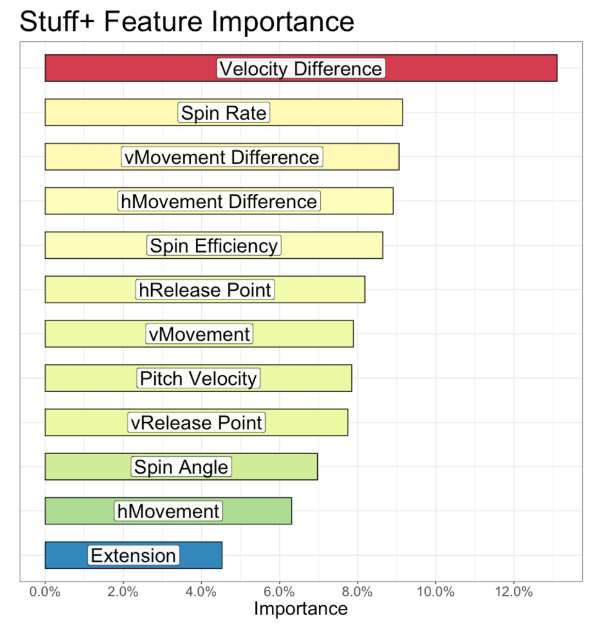
Following Eno Sarris’s example above, we created our weighted system by pitch type. Below is an example of the Sweeping Slider (Sweeper):
-
- 30% Vertical Movement Difference
- 20% Horizontal Movement Difference
- 20% Spin
- 20% Horizontal Break
- 10% Velocity Difference
Benefits of Stuff+
Stuff+ can help simplify the pitch design process by taking the guesswork out of figuring out what pitches work well off of each other. It can help give us a better idea of what pitches are working well off each other and what pitches need to be improved or scrapped.
For example, Logan Webb used Stuff+ to increase his sinker usage and decrease his 4-seam usage between 2020-2021. This allowed him to drop his ERA from 5.47 to 3.03 the following season and become an ace of the SF Giants pitching staff.

Source: PitchingBot Pitch Modeling Primer
Limitations
Although Stuff+ models can provide a good basis for evaluating pitches, there are a few limitations that it doesn’t take into account, including the following:
-
- Command / Location: The main limitation of Stuff+ is that it doesn’t evaluate how well a pitcher is able to locate his stuff. Command is obviously a huge piece of the puzzle, and needs to be considered when evaluating a pitch. If you can’t throw a pitch for a strike, it doesn’t matter how high a pitch’s Stuff+ grade is–it won’t be effective. Similarly, if a pitcher is able to locate a pitch extremely well, that pitch may perform well despite having a poor Stuff+ rating. Command specialists like Kyle Hendricks have commonly overperformed their Stuff+ expectations because of their ability to consistently locate their pitches on the edges of the zone.
- Deception: Stuff+ doesn’t take into account whether or not a pitcher’s delivery is deceptive. A submariner may have more success than their Stuff+ numbers may suggest because batters aren’t used to the low arm slot. Also, a pitcher who is able to hide the ball from the batter for longer may perform better than the Stuff+ number may suggest because the batter can’t identify the pitch as early.
- Pitch Sequencing: You have to be mixing up your pitches effectively throughout an outing in order to be effective. If you aren’t keeping the hitter guessing, they are going to have an easier time timing up your pitches, especially as you get deeper into games (if you’re a starting pitcher).
Our Model
With the help of the PitchingBot Stuff model, we made our own Stuff+ model for our college guys using college average data from Rapsodo. Similar to PitchingBot, our model uses the 20-80 scale to grade each pitch.
To do this, we first grade each characteristic (velo, movement, spin, etc.) on a 20-80 scale using the college averages and standard deviations on each characteristic. Although “+” stats are typically scaled with 100 being average, Stuff+ has become the more mainstream / well-known name, so that’s what we’re going to call it as well.
Depending on the pitch type, we assign weights to these characteristics that are most important for making that pitch elite. For example,
-
- 4-seam fastballs – the main contributors are velo, vertical break, and spin.
- Sinkers – we weigh horizontal break more heavily than vertical break, and so on.
We got the majority of these averages from Rapsodo, which can be found in the chart below. However, we had to fill in some of the gaps regarding some of the break characteristics of some pitches.
For instance, according to Rapsodo, the average vertical break on curveballs was -0.9 for RHP and -0.1 for LHP. We used MLB data as well as data from college guys in this facility to help fill in these gaps.
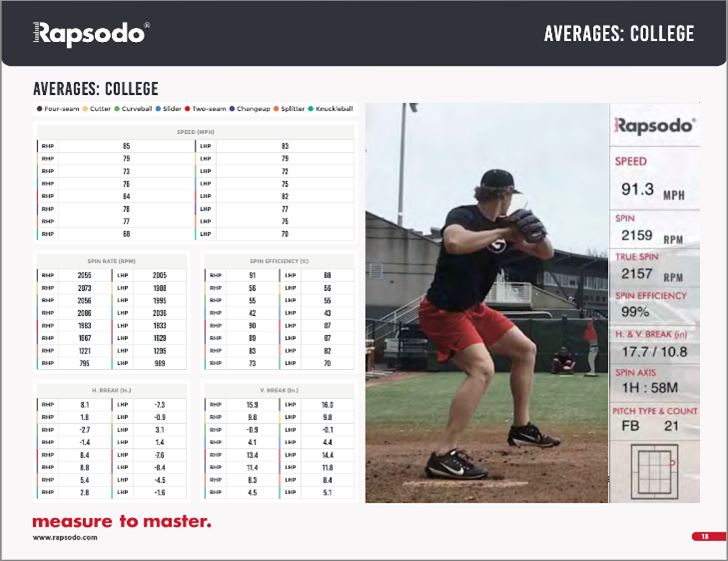
The following provides an example of how our Stuff+ model grades a bullpen thrown by one of the pitcher’s at RPP.
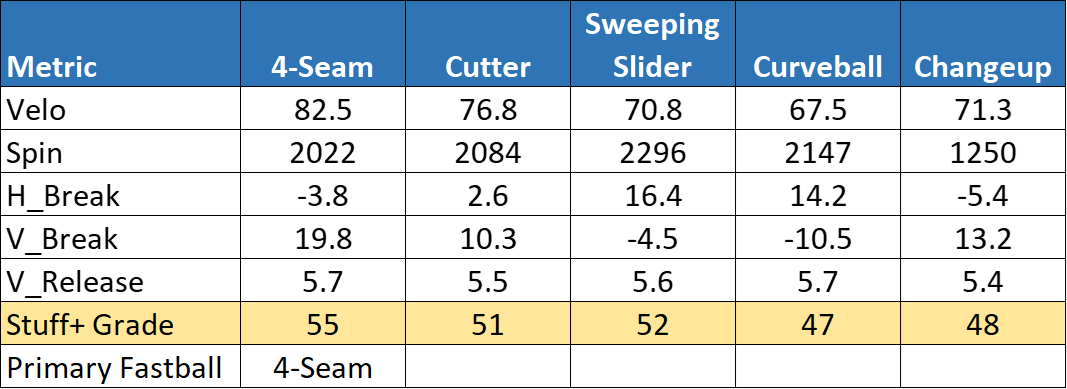
-
- 4-Seam: Our model grades this fastball as a 55 on the 20-80 scale. While the velo is a little below average for this college pitcher, he gets excellent vertical ride on it, which allows it to grade well on our scale. Focusing on increasing his velo would instantly make this pitch an elite one in his arsenal, possibly making it a 60-70 grade fastball.
- Cutter: The cutter grades out pretty average in every characteristic considered in Cutter stuff+, grading it as a 51. Spin is especially important for cutters since this pitch is thrown at a lower spin efficiency than both 4-seams and sinkers. He could also benefit from getting a tad more glove-side break on his cutter in order to maximize its potential.
- Sweeping Slider: This sweeper grades out at a 52. However, a deeper look into the pitch’s characteristics suggests that this pitch has a lot of potential. The main thing that sticks out with his sweeper is the amount of downward vertical break it gets. Typically, we want a sweeper to be more flat/horizontal, with the vertical break being at 0 are even slightly positive. Looking closer at his data, he had a 7:40 spin axis, meaning that he was getting more on top of the baseball rather than on the side of it. Focusing on getting on the side of his sweeper could help him eliminate some of the vertical break while also increasing the amount of sweep it produces.
- Curveball: This curveball grades out as below average at a 47. The main problem with the curveball is that he doesn’t get on top of it enough. When looking at curveballs, they should have more vertical break than horizontal break, otherwise it starts to become a slurve. The curveball has 4 more inches of glove-side break than vertical break, and thus profiles more as a slurve instead of a true curveball. If he could get more on top of his curveball, he could exchange some of that horizontal break for vertical break to get a true curveball. Having a true 12-6 curveball would also tunnel much better off his fastball since his fastball gets good vertical break with little arm side break.
- Changeup: Our model grades this out as a 48. However, this pitch does have immense potential. When looking at his changeup, what sticks out is the minimal amount of arm-side break it gets. Among 271 pitchers who throw a changeup with at least 500 pitches thrown this year, 253 of them throw one with at least 10 inches of arm side run. Because of lack of horizontal break on his changeup, his changeup is graded below average despite having good velo and vertical break difference from his fastball.
Closing Remarks
Stuff+ has become commonplace amongst MLB teams, who now have models of their own to evaluate a pitcher’s stuff. Generally, Stuff+ can help us get a better grasp on pitch design by condensing all the important metrics into one number for us to digest. It can also help us contextualize what Rapsodo is saying to our athletes, since it can be confusing for some at times. Stuff+ will allow us to evaluate how a pitcher’s stuff has evolved during his time with us and help us determine what pitches he should be throwing by the time the season starts.
By Brett Cerenzio (Data Analyst at RPP Baseball, rising Junior pursuing a Sport Analytics Bachelor’s Degree with a minor in Economics at Syracuse University, )
You live too far to train with us in-house at RPP? You can now train with us on a REMOTE basis.


